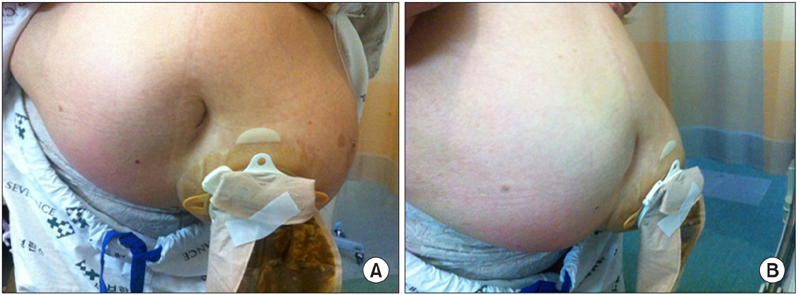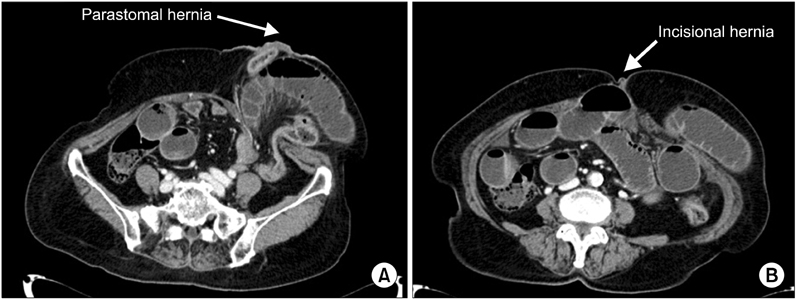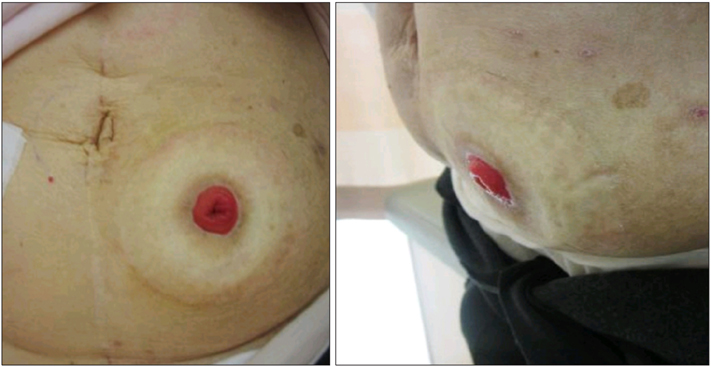J Korean Surg Soc.
2013 Jun;84(6):371-376. 10.4174/jkss.2013.84.6.371.
Laparoscopic repair of parastomal and incisional hernias with a modified Sugarbaker technique
- Affiliations
-
- 1Department of Surgery, Yonsei University College of Medicine, Seoul, Korea. namkyuk@yuhs.ac
- 2Department of Surgery, Hallym University Chuncheon Sacred Heart Hospital, Hallym University College of Medicine, Chuncheon, Korea.
- 3Department of General Surgery, McGill University, Montreal, QC, Canada.
- KMID: 1505188
- DOI: http://doi.org/10.4174/jkss.2013.84.6.371
Abstract
- A parastomal hernia is the most common surgical complication following stoma formation. As the field of laparoscopic surgery advances, different laparoscopic approaches to repair of parastomal hernias have been developed. Recently, the Sugarbaker technique has been reported to have lower recurrence rates compared to keyhole techniques. As far as we know, the Sugarbaker technique has not yet been performed in Korea. We herein present a case report of perhaps the first laparoscopic parastomal hernia repair with a modified Sugarbaker technique to be successfully carried out in Korea. A 79-year-old woman, who underwent an abdominoperineal resection for an adenocarcinoma of the rectum 9 years ago, presented with a large parastomal and incisional hernias, and was treated with a laparoscopic repair with a modified Sugarbaker technique. Six months after surgery, follow-up with the patient has shown no evidence of recurrence.
MeSH Terms
Figure
Reference
-
1. Carne PW, Robertson GM, Frizelle FA. Parastomal hernia. Br J Surg. 2003. 90:784–793.2. Safadi B. Laparoscopic repair of parastomal hernias: early results. Surg Endosc. 2004. 18:676–680.3. Hansson BM, de Hingh IH, Bleichrodt RP. Laparoscopic parastomal hernia repair is feasible and safe: early results of a prospective clinical study including 55 consecutive patients. Surg Endosc. 2007. 21:989–993.4. Rubin MS, Schoetz DJ Jr, Matthews JB. Parastomal hernia. Is stoma relocation superior to fascial repair? Arch Surg. 1994. 129:413–418.5. Lee YS, Lee IK, Oh ST, Kim JG, Jang SK, Kim YH. Laparoscopic giant parastomal hernia repair. J Korean Soc Coloproctol. 2005. 21:325–328.6. Asif A, Ruiz M, Yetasook A, Denham W, Linn J, Carbray J, et al. Laparoscopic modified Sugarbaker technique results in superior recurrence rate. Surg Endosc. 2012. 26:3430–3434.7. Sugarbaker PH. Prosthetic mesh repair of large hernias at the site of colonic stomas. Surg Gynecol Obstet. 1980. 150:576–578.8. Muysoms F. Laparoscopic repair of parastomal hernias with a modified Sugarbaker technique. Acta Chir Belg. 2007. 107:476–480.9. Bickel A, Shinkarevsky E, Eitan A. Laparoscopic repair of paracolostomy hernia. J Laparoendosc Adv Surg Tech A. 1999. 9:353–355.10. Stelzner S, Hellmich G, Ludwig K. Repair of paracolostomy hernias with a prosthetic mesh in the intraperitoneal onlay position: modified Sugarbaker technique. Dis Colon Rectum. 2004. 47:185–191.
- Full Text Links
- Actions
-
Cited
- CITED
-
- Close
- Share
- Similar articles
-
- Analysis of Risk Factors for the Development of Incisional and Parastomal Hernias in Patients after Colorectal Surgery
- Primary Repair of a Huge Incisional Hernia by Using an External Oblique Myofascial Releasing Technique without Mesh: A Case Report
- Laparoscopic Ventral Hernia Repair
- Incisional and Ventral Hernia Repair
- A Parastomal Hernia Causing Small Bowel Obstruction







